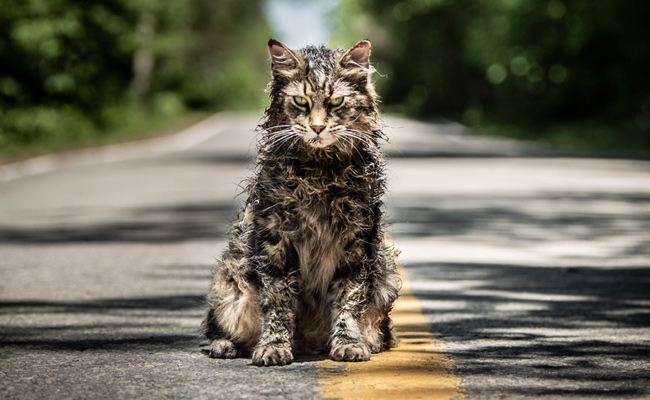
Pet Sematary is beautifully acted, suspensefully paced, competently staged, and overall is pretty successful at delivering that chilling sense of unease and redolent grossness that the best adaptations of Stephen King’s horror stories do. Yet its departures from the source material and from the previous, 1989 adaptation are lateral moves at best, and its capacity to ultimately deliver on the promise of its premise is middling — though not any more so than in the book or the previous adaptation.
The old knock on Stephen King from critics were that his books were kind of like fast-food hamburgers: unambitious product that you mostly got what you wanted out of, satiating if not especially stimulating. That feels extravagantly unfair to a writer the appeal of whose books seemed to cross all demographic lines, from young to old, rich to poor, highbrow to lowbrow. Everyone read Stephen King. I can remember my father and my juvenile delinquent best friend in middle school discussing the finer points of King’s stories together. I can’t imagine there will ever be another Stephen King, another author so prolific, so commercial, so critic proof, so widely discussed and actually worth discussing, in our lifetimes.
That being said, this Pet Sematary remake seems especially emblematic of that burger analogy. It gives us precisely what we expect — and presumably want — and not a whole lot more.
Jason Clarke plays Louis in this remake, directed by Kevin Kölsch and Dennis Widmyer, scripted by Matt Greenberg. Louis is a Boston doctor taking his wife, Rachel (Amy Seimetz) and two kids, Ellie and Gage, out to Maine where they can escape the rat race, live in a scary farmhouse, and presumably discuss all of Stephen King’s stories being set there. It turns out there’s a creepy pet cemetery on their property, a dangerous road running through it, and only their old salt of a neighbor, Jud (John Lithgow) knows the true secrets of the land.
First and foremost, the casting of this remake is spectacular. John Lithgow is one of our greatest and most underrated living actors, and Jason Clarke and Amy Seimetz, while they might lack some of Lithgow’s playfulness and range, have deep dramatic chops of their own and wonderful horror film faces. Likewise, Kolsch and Widmyer’s ability to stage and manage scenes for suspense and tension is fairly unimpeachable.
The obvious conceit of this story is that there’s a haunted pet cemetery where you can bury things and they come back — but not the same. “Sometimes dead is better,” goes the tagline. First it’s the family cat, Church, who Jud helps Louis bury in the haunted spot because he feels so bad about adorable Ellie losing her favorite pet. The cat comes back, only now with matted fur, odd (evil!) habits, and stinky. This was a bad call, because obviously most of a cat’s value comes from its cuddleability. They should’ve just adopted a new one that looked like Church. You’re telling me you couldn’t find another Maine coon? Please. You want a new Maine Coon, I can get you a Maine Coon by 3 pm, dude.
Anyway, it’s a great premise, playing on our twin fears of death (Louis is the realist, who doesn’t believe in an afterlife and wants to tell his daughter so; Rachel believes in an afterlife and thinks it’s cruel to tell their daughter that there’s nothing after) and rural spaces. I grew up way out in the country myself, and those nights when the dogs start inexplicably barking or a big bird lands on the roof and makes eerie scratching noises are just as scary as city slickers make them out to be.
That said, Pet Sematary never really finds that other gear. When the dead return, the idea is that they do so not as themselves, but as vessels for demons. The story hints at some of these demons being personal ones, like the undead suddenly knowing things their living form couldn’t have, like about Rachel’s sister, who withered and died from a spine disease when Rachel was a girl, sped along by an accident Rachel blames herself for. There’s also, kinda sorta, something to do with Jud’s dead wife, Norma. No demons for Louis, though, for whatever reason.
What would’ve made Pet Sematary truly special would’ve been if the story had been able to connect the character’s personal psychological scars, those “demons” of the natural world, like Rachel’s guilt over her sister and whatever we were supposed to get out of Jud and Norma, with the demons brought back from the pet cemetery — the story’s supernatural demons. Both the original story and this version sort of fumble toward that, but ultimately fall back on well-trod, cartoony ideas of “demons.” Hell fire and evil kids and so forth, everything but green puke and masturbatory crucifixes.
This new version changes a few things, like which human gets buried in the pet cemetery, and the ultimate outcome, but these are arbitrary updates. They don’t address the underlying story arc. And so while this competent version of Pet Sematary doesn’t do anything to lessen the impact or appeal of it source material, neither does it improve it. And so you leave it feeling, if not entirely satisfied, at least full.
You come for a Pet Sematary and a Pet Sematary you shall receive. A commerce done competently.
Vince Mancini is on Twitter. You can check out his archive of reviews here.






